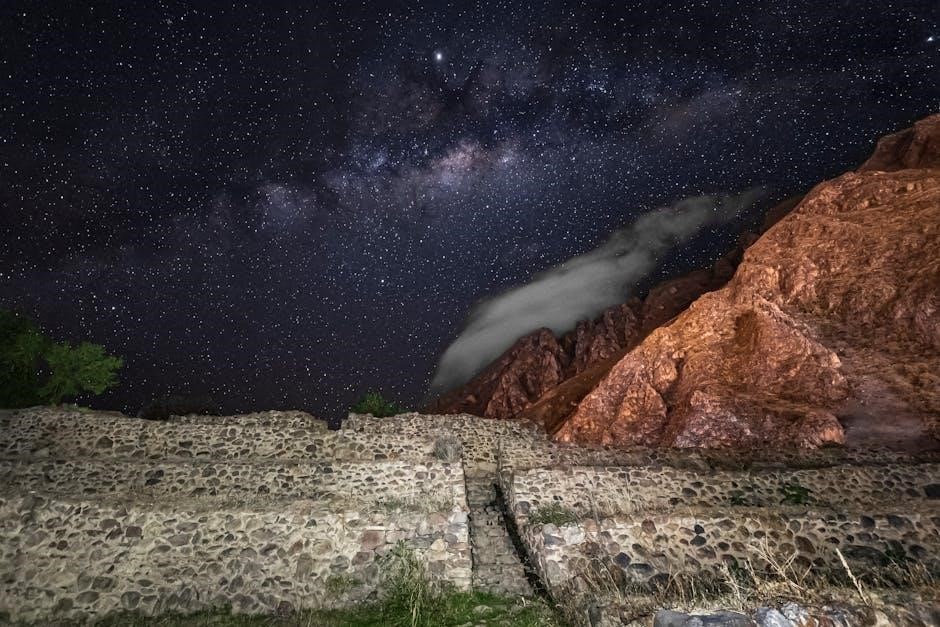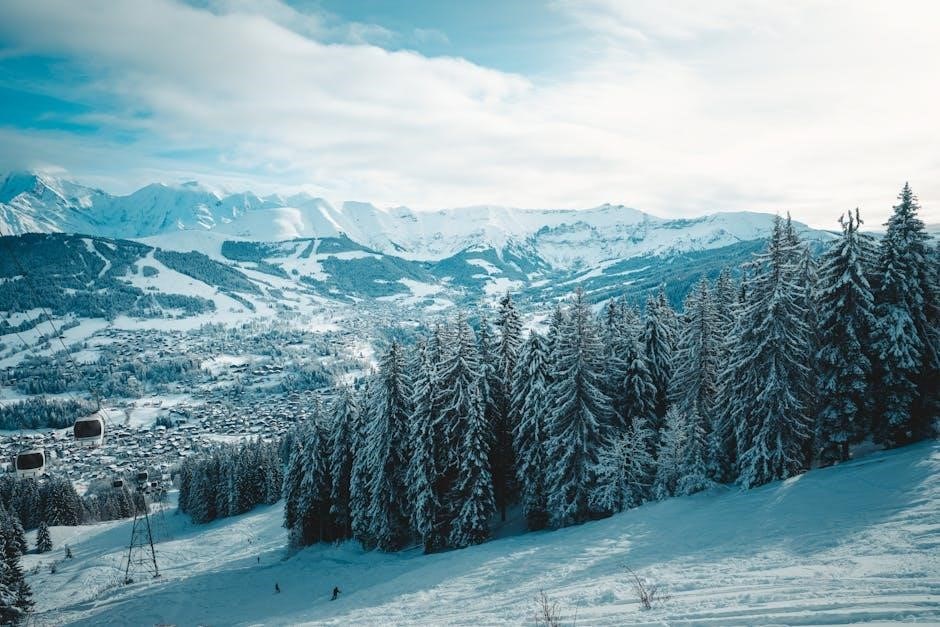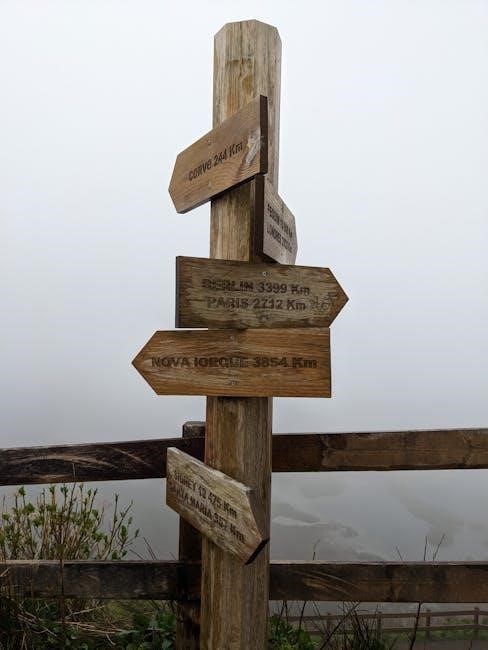Understanding the Role of a Mountain Guide
A mountain guide leads groups in mountaineering activities, ensuring safety and providing expertise in climbing, skiing, and navigation․ They must be proficient in multiple disciplines, such as rock, ice, and ski touring, while also instructing and managing groups effectively․
Gaining Extensive Mountaineering Experience
Gaining extensive mountaineering experience is a critical step to becoming a mountain guide․ It involves accumulating a wide range of skills and knowledge through hands-on practice in various mountain environments․ This includes spending a significant amount of time climbing and skiing in different terrains, such as rock, ice, and backcountry snow․ Starting with basic climbs and gradually progressing to more challenging routes helps build the necessary expertise․ Climbing as much as possible, whether on local peaks or in more remote locations, is essential․ Additionally, backcountry skiing experience is crucial, requiring comfort and proficiency in diverse snow conditions․ Versatility in different types of terrain is vital for a mountain guide, as it prepares them to handle various scenarios and conditions․ Frequent trips to the mountains, for both climbing and skiing, not only build experience but also enhance understanding of weather conditions and potential hazards․ While there may not be a specific number of hours or climbs required, the focus should be on the quality and diversity of experiences gained․ Reaching out to experienced climbers or guides can provide valuable insights and recommendations on the best routes and locations for training․ Ultimately, extensive mountaineering experience is about mastering a broad spectrum of skills and knowledge through consistent and varied practice in the mountains․
Obtaining Necessary Certifications
Obtaining the necessary certifications is a cornerstone of becoming a professional mountain guide․ These certifications ensure that guides meet rigorous standards of safety, expertise, and professionalism․ The most recognized certification is the IFMGA (International Federation of Mountain Guides Associations) certification, which is highly respected worldwide․ To achieve this, one must complete advanced training in climbing, skiing, and avalanche safety, followed by a series of assessments․ Additionally, certifications like the AMGA (American Mountain Guides Association) in the U․S․ or the UIAGM in Europe are also essential․ Many guides also pursue specialized certifications, such as AIARE (American Institute for Avalanche Research and Education) for avalanche safety or single-pitch instructor certifications for rock climbing․ These programs involve intensive training, practical exams, and ongoing education to stay updated on best practices․ Certifications not only validate a guide’s skills but also build trust with clients, ensuring they are in capable hands․ The process of obtaining these certifications is rigorous, requiring dedication and a commitment to continuous learning․

Building Physical Fitness
Physical fitness is a cornerstone for aspiring mountain guides, as the demands of climbing, hiking, and carrying heavy packs require exceptional strength and endurance․ Building cardiovascular endurance through activities like running, cycling, or hiking is essential to handle long, strenuous days in the mountains․
Muscular strength, particularly in the legs, core, and upper body, is critical for stability and maneuvering on uneven terrain․ Guides often engage in strength training exercises, such as squats, lunges, and rock climbing, to build the necessary power and agility․
Flexibility and mobility are also vital to navigate technical routes and avoid injuries․ Incorporating stretching and yoga into a fitness routine can improve range of motion and overall physical resilience․ Mental stamina is equally important, as guides must remain focused and composed under pressure․
A well-rounded fitness regimen, combined with consistent practice and progression, ensures that mountain guides can perform safely and effectively in challenging environments․ This physical preparation is a lifelong commitment, as the demands of the job require continuous improvement and adaptation․

Taking Essential Courses
Taking essential courses is a critical step in becoming a mountain guide, as they provide the necessary knowledge and skills to lead safely and effectively․ Many aspiring guides start with foundational courses in avalanche safety, wilderness first aid, and crevasse rescue techniques․
Advanced courses in technical climbing, such as ice climbing and rock climbing, are also indispensable․ These programs teach the mechanics of anchor placement, rope work, and hazard assessment, ensuring guides can handle complex terrain with confidence․
Certification programs, such as those offered by the American Mountain Guides Association (AMGA) or the International Federation of Mountain Guides Associations (IFMGA), are highly recommended․ These courses cover a wide range of topics, from navigation and route planning to group management and emergency response․
Additionally, guides often pursue specialized training in areas like ski mountaineering or high-altitude climbing to broaden their expertise․ Continuous education and skill refinement are essential, as the role demands constant adaptation to new challenges and evolving best practices․
By completing these courses, aspiring guides gain the technical proficiency and decision-making abilities needed to lead climbers and skiers safely in the mountains․
Developing Navigation Skills
Navigation is a cornerstone skill for any aspiring mountain guide, as it ensures safe and efficient travel in complex terrain․ Developing strong navigation skills involves mastering map reading, compass use, and GPS navigation, as well as fostering situational awareness․
Prospective guides should practice interpreting topographic maps to identify landmarks, trails, and potential hazards․ Understanding how to triangulate positions and estimate distances is crucial for accurate route planning․ Additionally, compass skills, such as orienting the map and taking bearings, are essential for maintaining direction in challenging environments․
Experience in various conditions, including low visibility and unfamiliar terrain, helps refine these abilities․ Guides must also learn to recognize natural navigation aids, such as ridges, valleys, and drainage patterns, to supplement their tools․ Regular practice and real-world application of these skills build confidence and precision․
By combining traditional navigation techniques with modern tools like GPS devices, guides can ensure accuracy and reliability, even in remote or high-stress situations․

Cultivating Leadership and Group Management Skills
Leadership and group management are critical skills for a mountain guide, as they are responsible for the safety and success of their clients in challenging environments․ Developing these skills involves learning to make sound decisions, communicate effectively, and manage group dynamics․
A guide must be able to assess the abilities and limitations of their clients, ensuring that the group stays cohesive and motivated․ Strong communication skills are essential for providing clear instructions and reassurance, especially in high-stress situations․ Additionally, guides must be adept at conflict resolution and fostering a positive team atmosphere․
Leadership also requires the ability to adapt plans based on changing conditions, such as weather or terrain difficulties․ Guides must be proactive in identifying potential risks and taking steps to mitigate them․ Building trust with clients through professionalism and empathy is equally important․
By honing these leadership and group management skills, aspiring guides can create safe and enjoyable experiences for their clients while maintaining control and confidence in the mountains․

Understanding the Outdoor Environment
Understanding the outdoor environment is a cornerstone skill for aspiring mountain guides, as it ensures safety and informed decision-making in the field․ This involves recognizing and interpreting natural features, weather patterns, and ecological conditions․
A guide must be adept at reading terrain, identifying potential hazards such as avalanches, rockfall, and unstable ice, and navigating using maps and compasses․ Knowledge of local flora and fauna can also aid in route planning and environmental awareness․
Weather forecasting is critical, as guides need to predict and prepare for changing conditions that could impact safety․ This includes recognizing signs of storms, understanding snowpack stability, and assessing temperature variations․
Ecological awareness is equally important, as guides must minimize their impact on fragile mountain ecosystems and promote sustainable practices․ By deeply understanding the outdoor environment, guides can lead safe, responsible, and enjoyable expeditions in diverse and challenging settings․
Networking in the Climbing Community
Networking in the climbing community is essential for aspiring mountain guides, as it provides opportunities to learn from experienced professionals and gain insights into the industry․ Building relationships with other climbers, guides, and outdoor enthusiasts can open doors to mentorship, job opportunities, and valuable advice․
Joining local climbing clubs, attending workshops, and participating in outdoor events are great ways to connect with like-minded individuals․ These interactions can help you stay updated on industry trends, best practices, and safety standards․ Additionally, networking with certified guides can offer firsthand knowledge about the challenges and rewards of the profession․
Online forums and social media groups dedicated to mountaineering can also serve as valuable resources for networking․ Sharing experiences and seeking feedback from the community can enhance your skills and confidence․ By fostering these connections, you can build a strong foundation for your career as a mountain guide․

Pursuing Apprenticeships
Pursuing apprenticeships is a critical step in becoming a mountain guide, as it provides hands-on experience and mentorship from experienced professionals․ These programs allow aspiring guides to learn the practical skills needed for leading groups in various mountain environments․
Many apprenticeships are offered through professional organizations or certified guides․ These programs typically involve working alongside seasoned guides, assisting on climbs, and gaining exposure to real-world scenarios․ Apprenticeships often focus on specific disciplines, such as rock climbing or ski mountaineering, and may require meeting certain prerequisites, like extensive climbing or skiing experience․
The apprenticeship process helps refine skills such as route selection, hazard assessment, and group management․ It also provides opportunities to develop decision-making abilities in high-pressure situations․ By completing an apprenticeship, individuals demonstrate their commitment to the profession and build a solid foundation for advancing their careers as mountain guides․
Applying for Certification
Applying for certification is a milestone in becoming a mountain guide, as it validates your skills and experience․ Most countries require guides to be certified by recognized organizations, such as the International Federation of Mountain Guides Associations (IFMGA) or the American Mountain Guides Association (AMGA)․
To apply, you must meet specific prerequisites, which often include extensive mountaineering experience, completion of training programs, and demonstrated proficiency in climbing, skiing, and safety protocols․ The certification process typically involves submitting an application, paying fees, and passing a rigorous assessment․
The assessment evaluates your technical skills, decision-making abilities, and leadership qualities․ Once certified, you gain recognition as a qualified professional, which enhances your credibility and career opportunities․ Certification also demonstrates your commitment to upholding safety standards and ethical practices in the mountains․

Maintaining Commitment and Patience
Becoming a mountain guide requires unwavering commitment and patience․ The journey is long and demanding, with years of dedication needed to master the necessary skills․ Guides must consistently climb, ski, and navigate challenging terrain to build expertise and stay current with evolving techniques and safety standards․
Patience is crucial, as progress may be gradual; Each experience, whether successful or not, contributes to growth․ Guides must embrace setbacks as learning opportunities, staying resilient in the face of adversity․ Additionally, maintaining a long-term vision helps sustain motivation through the rigorous training and certification process․
Commitment also extends to continuous learning and self-improvement․ Guides must stay updated on best practices, new technologies, and environmental awareness․ By fostering a mindset of persistence and dedication, aspiring guides can navigate the challenges and achieve their goal of leading others safely and effectively in the mountains․